How your top-tipped ASX large-caps of 2023 fared
Looking back over the stocks named last year by Livewire readers, the love affair with battery metals caused some red ink to be spilled in the performance stakes. As the following list shows, the big lithium plays Allkem (ASX: AKE) and Mineral Resources (ASX: MIN) delivered negative returns in the calendar year to the end of November. Also dipping into the red was a biomedical firm that’s long been lauded as one of Australia’s most successful multinational companies.
It was a different story for the mainstream commodities companies, with two of the ASX’s biggest miners ranking second and third in terms of performance.
The commentary following the table below works through each of these, from number 1 through to number 10, helping to bring you up to date with the big news items for each of them across 2023.
NOTE: This list reflects views held by a subset of Livewire’s audience. It is intended to inspire ideas for your investment research but is not financial advice. Before making any investment decision, always consult a professional adviser who can consider your own circumstances.
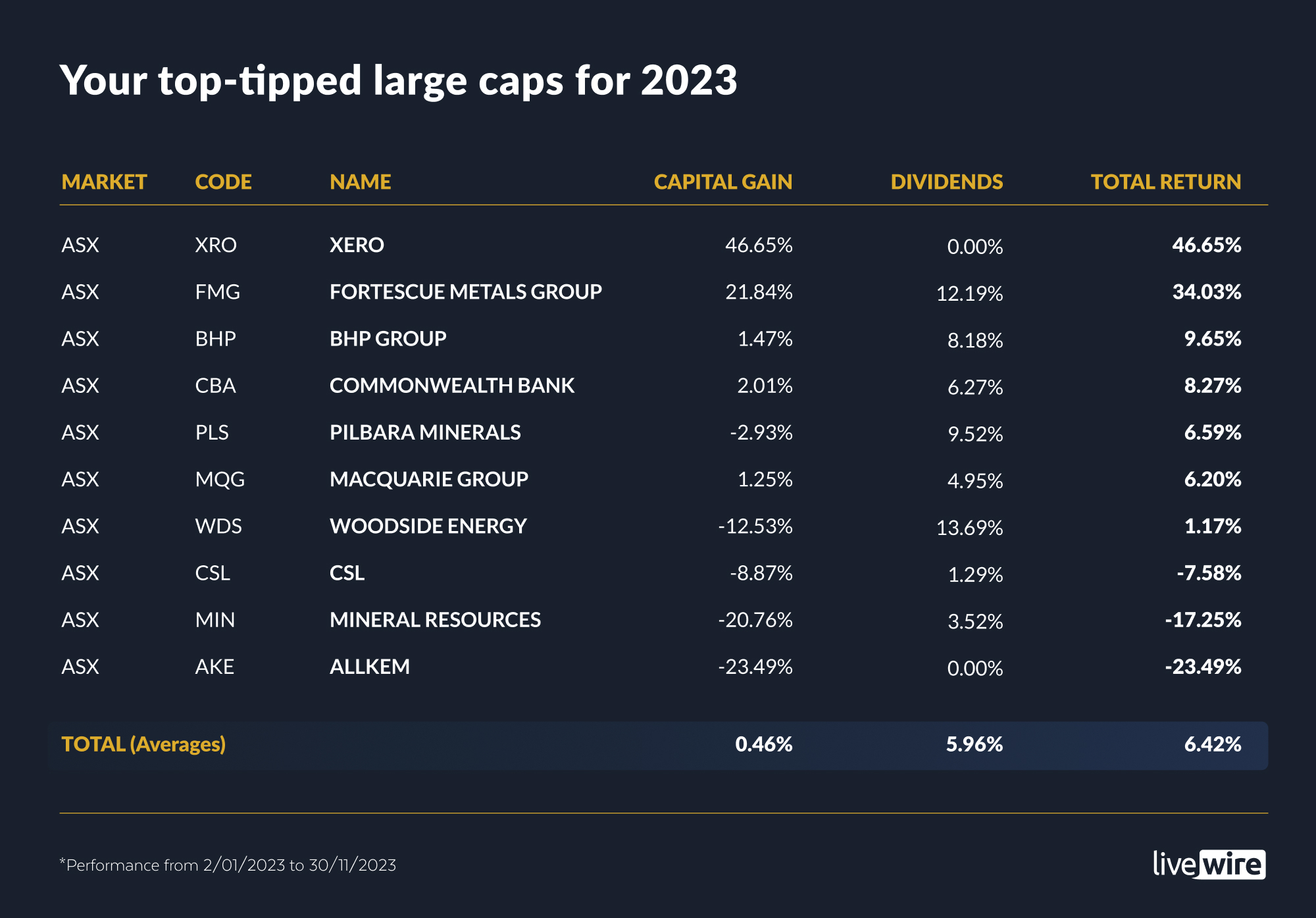.jpg)
1. Xero (ASX: XRO): 46.65%
- Market cap: $15.32 billion
- Broker consensus: STRONG BUY based on 20 rating (15 buy, 5 hold, 0 sell)
The accounting software firm has long been a poster child for successful Australian “network effect” businesses. But it was also unprofitable for much of the time since it was founded in New Zealand in 2006, only announcing its first profit back in 2018.
For a while now, Xero has been walking a tightrope between profit and revenue growth – a struggle that underpinned its 12% share price fall on the back of its first-half earnings announcement on 9 November.
Market Matters’ James Gerrish recently reaffirmed his holding of the stock: “We believe the reaction to the miss has been overdone and primarily driven by the market being long/overweight the stock after May’s strong earnings report.”
Gerrish noted he was keen to see the outcome of Xero’s review of its US business, in which the firm has invested around $30 million in the last decade.
“However, we are looking to reduce our tech exposure in 2024, which compounds why we don't want to fade this initial knee-jerk to the downside,” he said.
“But we do think the business is moving towards a more solid, balanced footing as they leverage the nearly 4 million customers they have globally.”
That said, Gerrish also believes the share price will “struggle to push meaningfully higher in the short term.”
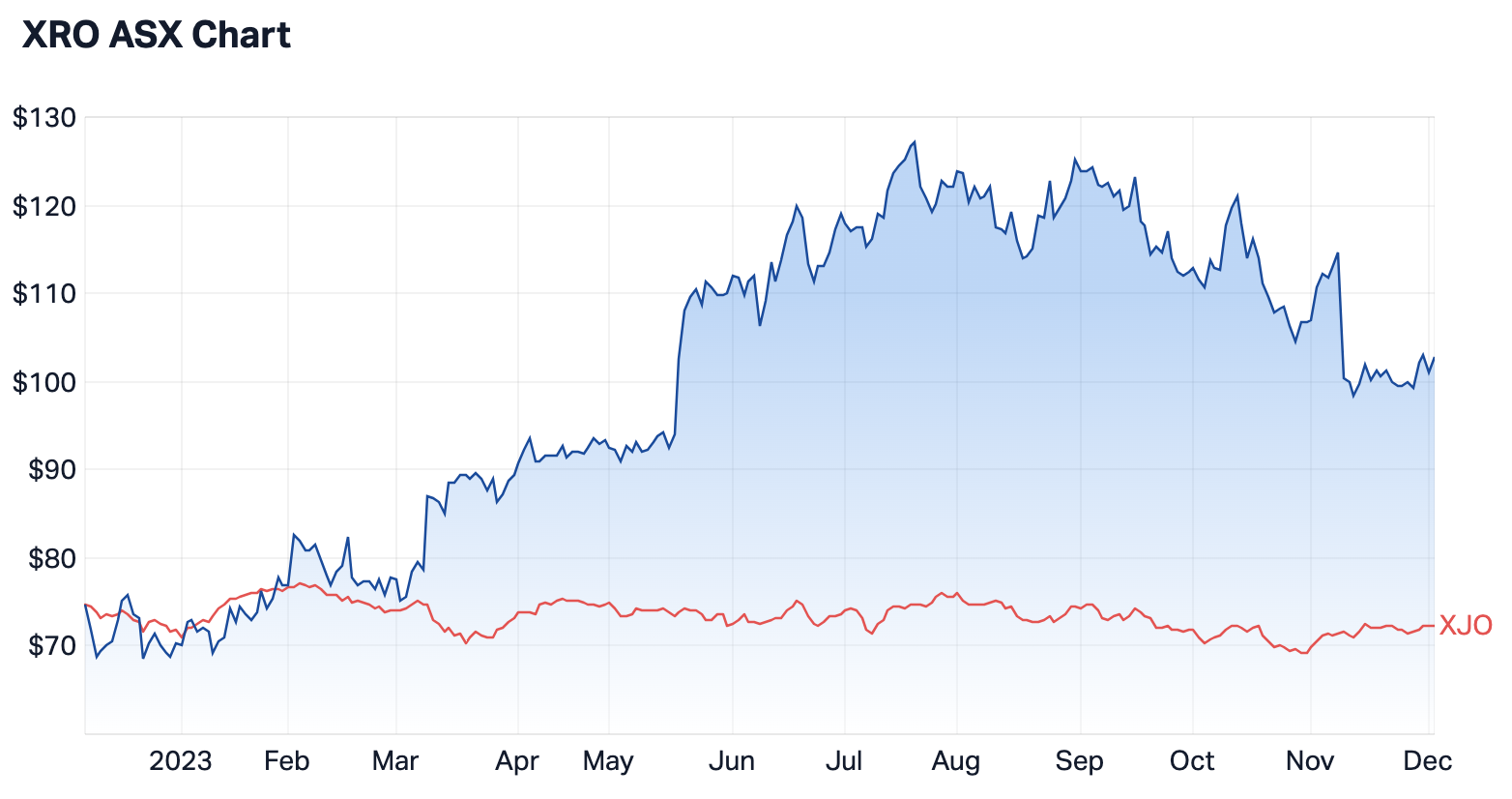
2. Fortescue Metals Group (ASX: FMG): 34.03%
- Market cap: $77.59 billion
- Broker consensus: STRONG SELL based on 20 ratings (2 buy, 4 hold, 14 sell)
The top-tier iron ore producer has been in the headlines for many other reasons recently, namely its founder, former CEO and now chairman Andrew Forrest’s push of several “clean energy” projects via its Fortescue Future Industries business.
But the firm has been caught up in the recent iron ore rally, as Livewire’s Hans Lee noted earlier this week. Singapore-based iron ore futures contract prices rallied 20% in the last quarter alone.
“The share price is now up 12% over the last month and 30% over the past year as a result. Not bad for a company that has had 10 executives leave in less than three years,” wrote Lee.
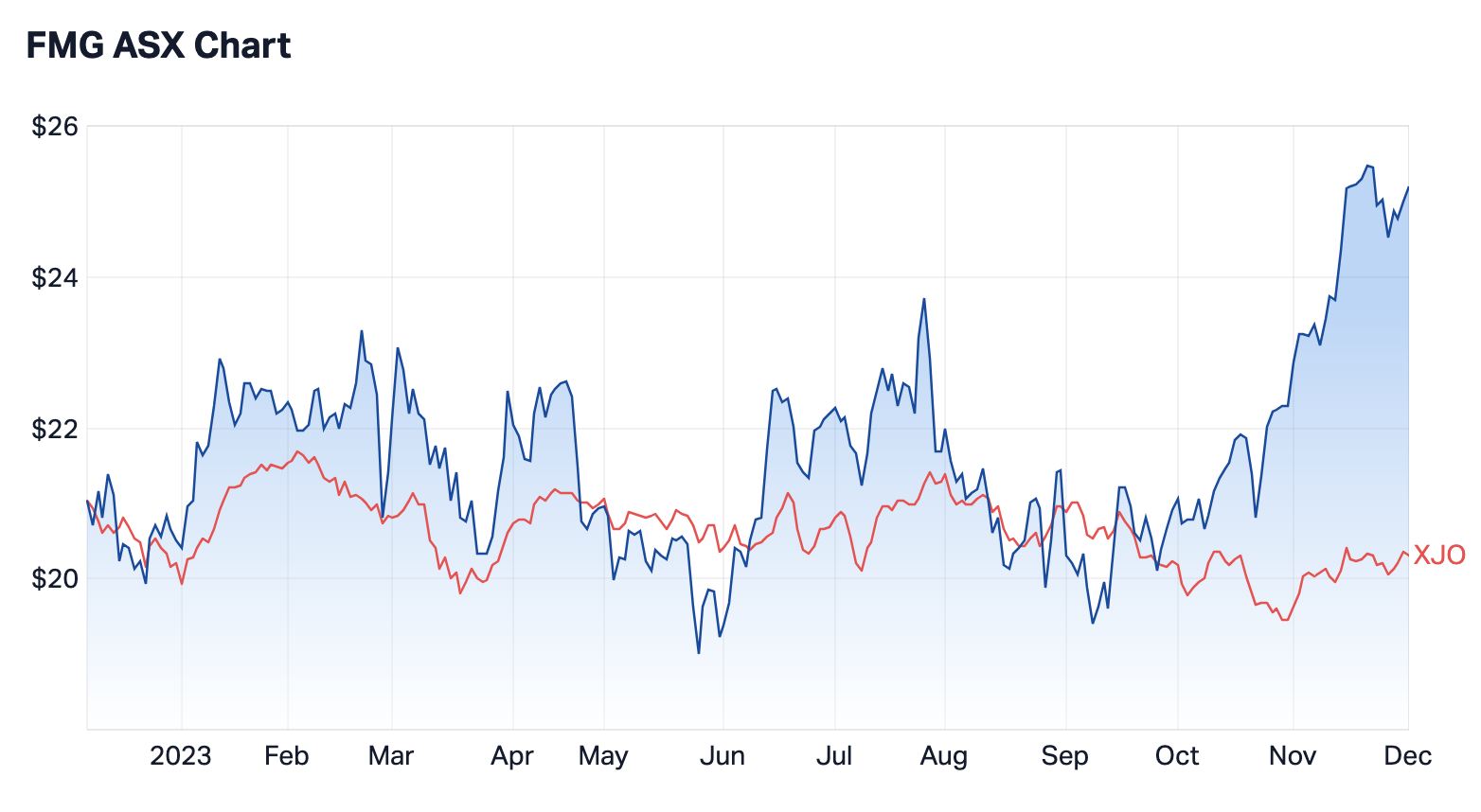
3. BHP Group (ASX: BHP): 9.65%
- Market cap: $235.29 billion
- Broker consensus: BUY based on 22 ratings (10 buy, 10 hold, 2 sell)
Primarily known for its iron ore and copper production – which are BHP’s biggest profit centres – it’s also a large producer of another material garnering huge investor focus: uranium.
As Livewire’s Carl Capolingua recently pointed out, “The Big Australian” now accounts for 7% of global uranium production.
It’s BHP’s copper production that ties it to one of the biggest long-term investment themes of electrification, as noted in a recent article by Wilsons Advisory’s Rob Crookston.
But he believes now is a good time to trim profits on BHP, given it has so soundly beaten the ASX 300 over the last month, three-month and six-month periods. Wilsons prefers Sandfire Resources (ASX: SFR) as a pure-play exposure to copper.
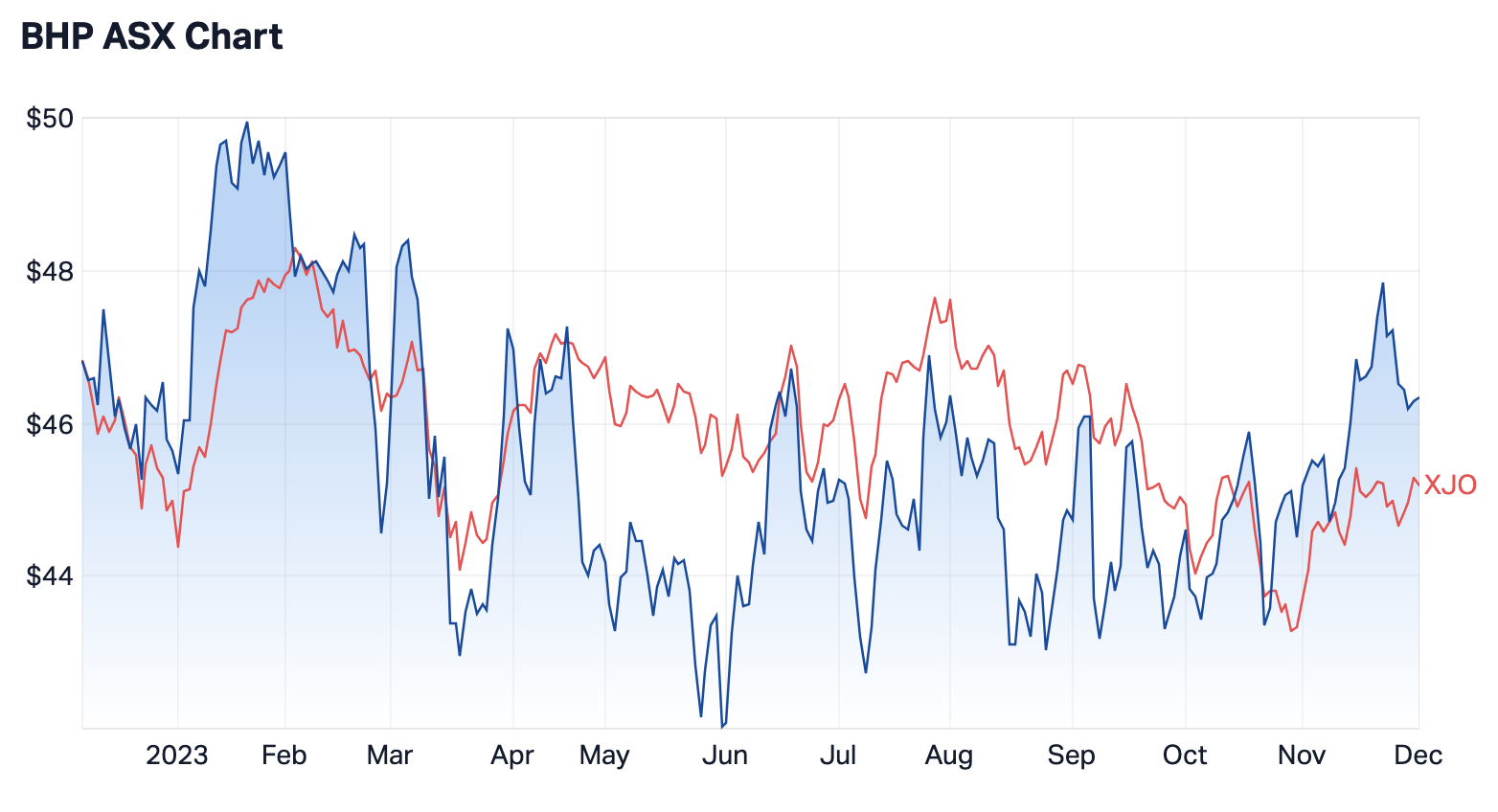
4. Commonwealth Bank of Australia (ASX: CBA): 8.27%
- Market cap: $175 billion
- Broker consensus: STRONG SELL based on 20 ratings (0 buy, 5 hold, 15 sell)
Australia’s largest bank, Commonwealth Bank is also one of the most exposed to the tougher economic environment including squeezed conditions for mortgage holders. This is possibly why it’s rated a SELL by Citi (as is National Australia Bank (ASX: NAB).
In a recent note, as reported by Livewire’s Kerry Sun, Citi analysts said: “We believe the current set of price-to-earnings are not reflective of the growth and risk profile and, thus we no longer have any Buy recommendations amongst the Major Banks.”
But the bank also has plenty of rusted-on supporters – and not just among Livewire’s readership.
FNArena’s Rudi Filapek-Vandyck recently explained his belief that many investors simply can’t get their head around the bank’s valuation, describing it as: “The only bank in Australia that has been worth owning post-GFC.”
“To properly assess the prospects and 'valuation' of CommBank, one must compare and measure against the rest of the sector domestically,” he said.

5. Pilbara Minerals (ASX: PLS): 6.59%
- Market cap: $10.91 billion
- Broker consensus: BUY based on 20 ratings (11 buy, 7 hold, 2 sell)
The third battery metals miner on the list, it’s recently emerged that Pilbara Minerals is also popular with short sellers. Livewire’s Kerry Sun just a couple of days ago cited PLS among a few battery metals names that have seen a spike in short interest.
In the absence of an easier, futures-based method of shorting lithium, the Australian-focused producer seems to have been adopted as a proxy. If you’re interested in learning more details about the knockout battle between the lithium faithful and short sellers playing out in the PLS share registry, don’t miss this piece by Livewire’s Carl Capolingua.
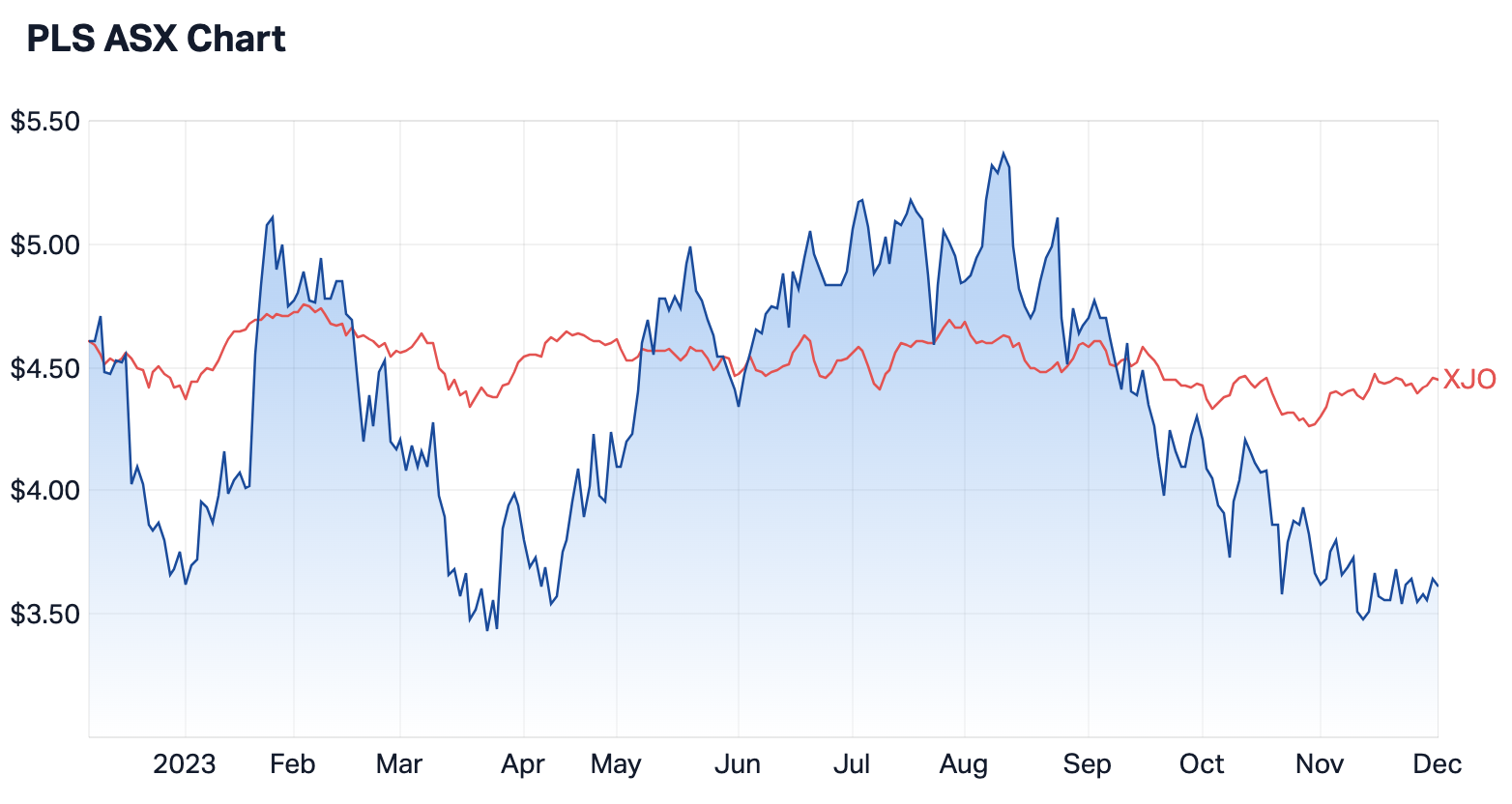
6. Macquarie Group (ASX: MQG): 6.20%
- Market cap: $64.7 billion
- Broker consensus: BUY based on 16 ratings (11 buy, 5 hold, 0 sell)
Australia’s “other” big financial firm, frequently mentioned alongside the big four banks, Macquarie recently announced a $2 billion buyback and a healthy dividend, despite the challenging climate for financial markets.
This followed the bank’s reported 39% dip in net profit for the first half of fiscal 2023.
Marcus Today’s Henry Jennings recently provided Market Index with his view on the buyback decision: "It helps sentiment, the surplus capital is part of it too, but the buyback puts a floor under the stock a little. It also helps to suck up any stray sellers from time to time.”
That said, Jennings isn’t an owner of the stock. “We do not hold, and we haven’t for a while as we suspected this result was not going to be great. We are happy to sit it out for now,” he said.
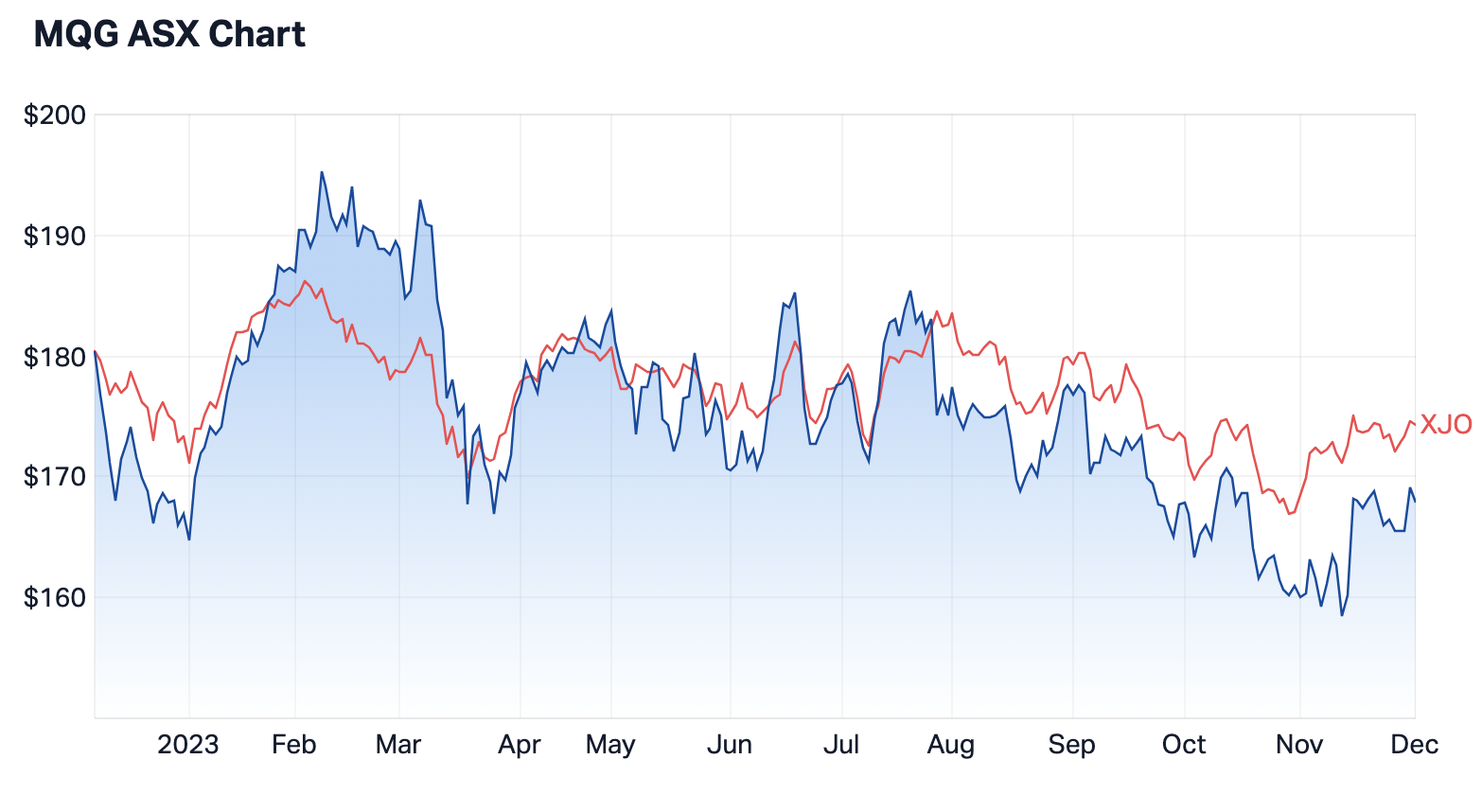
7. Woodside Energy Group (ASX: WDS): 1.17%
- Market cap: $58.58 billion
- Broker consensus: BUY based on 18 ratings (9 buy, 6 hold, 3 sell)
Australia’s largest energy company, Woodside’s oil and gas operations also span North America, Asia, and Africa. It’s commonly named alongside other high-quality ASX companies, which have been favoured by investors in the last 18-plus months.
Woodside’s clear leadership in natural gas production places it in an enviable position – which is possibly why it’s also cropped up more recently in discussions about other potential M&A targets. This follows on from the high-profile $20 billion bidding war for another large Australian energy company, Origin, whose board recently rebuffed a third offer from Brookfield and EIG.

8. CSL Limited (ASX: CSL): -7.58%
- Market cap: $128.07 billion
- Broker consensus: STRONG BUY based on 21 ratings (17 buy, 3 hold, 1 sell)
The biomedical firm beloved of many ASX large-cap investors, CSL’s inclusion in this surprised nobody. And yet, it has faced plenty of criticism more recently.
The company in October welcomed a new CEO in Paul McKenzie, only its third leader since the firm was privatised (from Commonwealth Serum Laboratories) back in 1994. He’s already faced tough questions from shareholders at its AGM, particularly around CSL’s only earnings downgrade in recent memory in June. The company is one of a couple said to be under threat from generic treatments including those of Novo Nordisk’s blockbuster obesity drug Ozempic.
But Livewire contributor favourite Rudi Filapek-Vandyck – a long-time fan of the multi-national firm – is among many who remain unphased.
In a recent Livewire article, Rudi described CSL as: “One of Australia's most successful business stories from the past three decades, widely regarded as the benchmark for 'quality' on the ASX.”
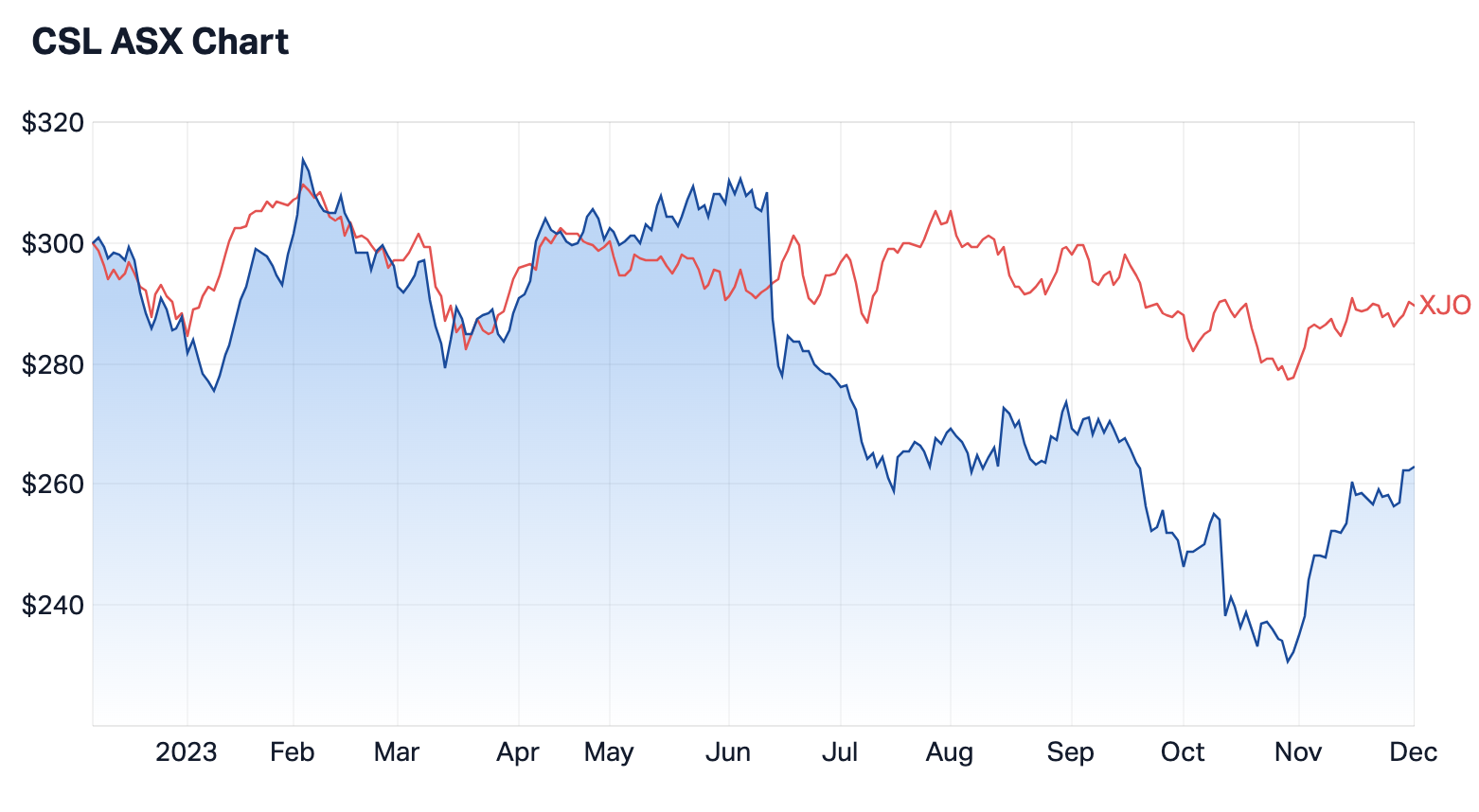
9. Mineral Resources (ASX: MIN): -17.25%
- Market cap: $11.76 billion
- Broker consensus: BUY based on 20 ratings (15 buy, 2 hold, 3 sell)
A diversified mining company, Mineral Resources’ primary businesses are in mining services and the production of lithium and iron ore. The company is often cited as an example of stellar management, led by Australian mining sector veteran Chris Ellison. “Ellison’s deals could be the seeds of a future lithium juggernaut that only Mineral Resources is capable of commercialising given their competitive advantages in logistics,” wrote Blackwattle Investment Partners’ Ray David on Livewire last month.
And with a raft of M&A activity in the space – notwithstanding Gina Rinehart’s block trades – who knows what 2024 might bring for the company and its shareholders? Long-time Livewire contributor Barry Fitzgerald in September made a bold call on the lithium supply-demand dynamic: “The current lithium price weakness could be swept away soon anyway as the weaker prices are beginning to knock out higher-cost Chinese supply, opening up a widening supply gap.”
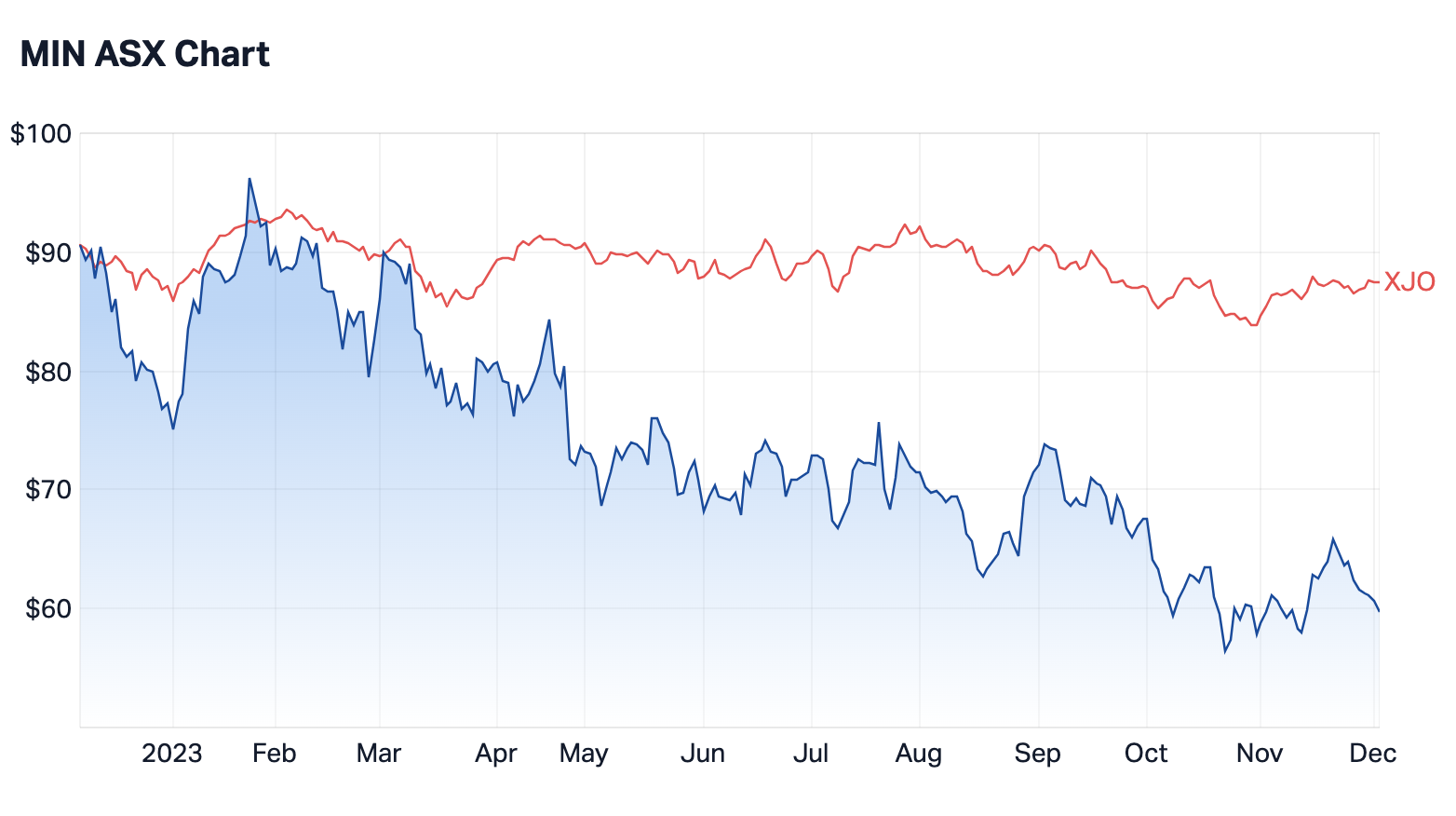
10. Allkem (ASX: AKE): -23.49%
- Market cap: $5.44 billion
- Broker consensus: STRONG BUY based on 21 ratings (16 buy, 4 hold, 1 sell)
Australia’s highest-profile lithium play, Allkem was formed out of the 2021 merger of Galaxy Resources and Orocobre. As shown in the below chart, the firm’s share price performance versus the index in 2023 has been underwhelming. This has coincided (unsurprisingly) with the movement of the lithium price, which is down about 75% in the year so far. Livewire’s Carl Capolingua recently detailed some of the reasons for this, discussing both the bear case and the bull case. This positive viewpoint is one that’s being firmly embraced by the lithium faithful – and it’s on display in this Livewire top-tipped list, which features three lithium producers. It remains to be seen how welded-on these investors remain if the substantial downside electric vehicle sales risks, as cited by the likes of Morgan Stanley, play out in 2024.
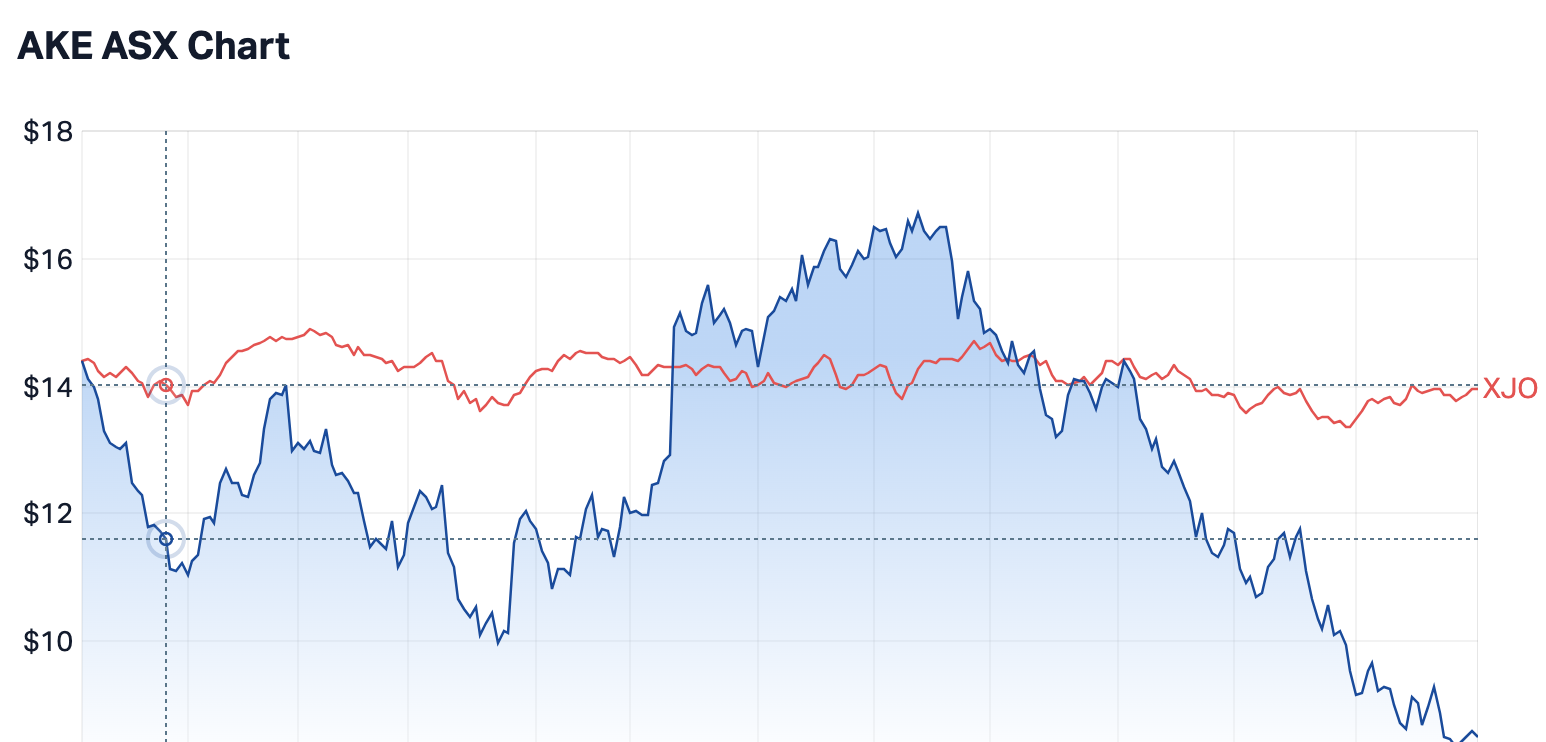
Get in touch
Do you have thoughts of your own on how some of these companies performed in 2023? Better still, what will you be watching most closely in 2024? Let us know in the comments below.
3 topics
11 stocks mentioned



